

Designation:SOC Surface-to-Orbit Defense Headquarters/ GMU Ground Mobile Siege Unit |
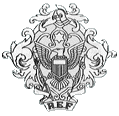
|
||||
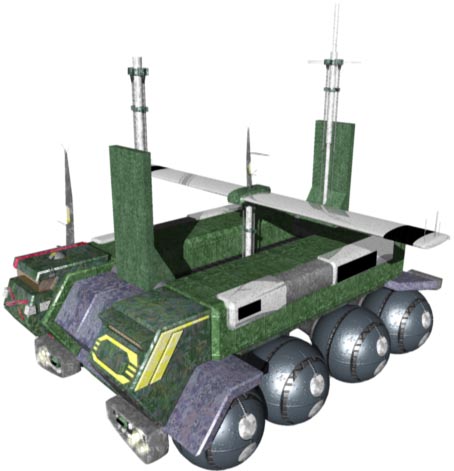
|
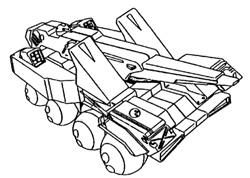
|
||||


| SOC class mobile surface to orbit defense headquarters | (2021-2030, 2033-2046) |
| GMU class mobile siege engine | (2030-2033) |
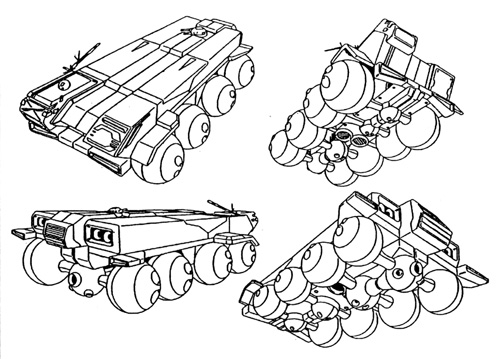
| Titan | SOC-01 | Destroyed 2044 over Earth with UES Saratoga (SDBC-69). |
| Colossus | SOC-02 | To reserve 2046, sold 2050 to the Terran War Museum, Oxford. |
| Leviathan | SOC-03 | Destroyed 2044 over Earth with UES Hood (SDBC-47). |
| Goliath | SOC-04 | To reserve 2045, Fantoma Orbital Storage, Vallivarre system. |
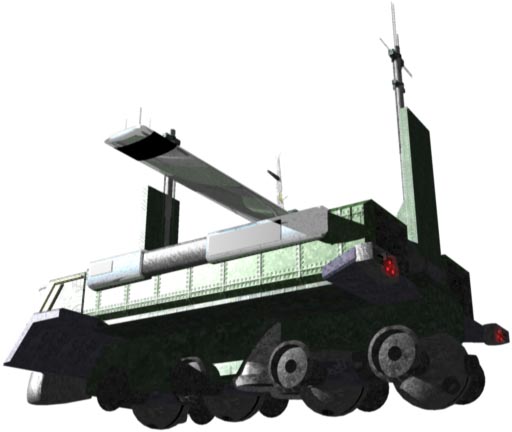
The SOC was without doubt the oddest re-entry capable vehicle ever to be designed by Terran engineers. Looking like nothing so much as a wheel-less, floating, fat brick, the image only worsened when the eight droppods were mounted on the underside.
Designed as a mobile headquarters and launcher for the REF ground-based orbital defenses, the SOC contained a {raised center on top} with two banks of eight silo's for Skylord ground-to-orbit missiles. In addition, two large sensor towers were placed {alongside the missile launchers}, and numerous ESM flush arrays were mounted on the upper works. Two relatively small point-defense missile batteries in the back of the superstructure (after the 2033 refit) and one small particle gun turret on top of the cockpit forward of the superstructure provided the only close-in defensive armament. A small mecha hangar was located on the left side of the fuselage.
The GMU had, as described, a cockpit section forward of the superstructure, offset to the right. Offset to the left was the hangar. The center, raised, section of the superstructure was devoted to the electronics of the headquarters and the personnel that operated them. The two flanks housed the staff proper, including their quarters, meeting rooms, briefing rooms, etcetera.
The upper frame housed the reflex furnaces and many of the flight support systems such as the life support; the engine and flight systems such as the anti-gravity units were mounted in four docking/engine spheres below the frame. These docking spheres could accommodate up to eight large standard docking pods, which were detached prior to re-entry, and attached in the atmosphere for orbital lift. The drop-pods were fitted with remote radar and optical orbital sensors, and would be dropped into a precise pattern for maximum over-the-horizon sensor coverage.
During their refit in 2030, the central and side superstructures were removed. In their place came two rotating side bodies, containing the gun control equipment and the nuclear missile battery. The large cannon was mounted on the centerline, and two large flare shields were fitted to the sides. The front cockpit and mecha bay remained in place; although both had to be evacuated for safety reasons when the cannon was firing. A secondary particle beam turret was mounted on top of the cannon barrel, although it too could not be operated in the main cannon fired.
After their re-conversion in 2033, the SOC vehicles mounted the superstructures as they had when they were completed; these had been stored while they functioned as GMU's. At this time the armament was expanded with two close-in defense missile batteries.
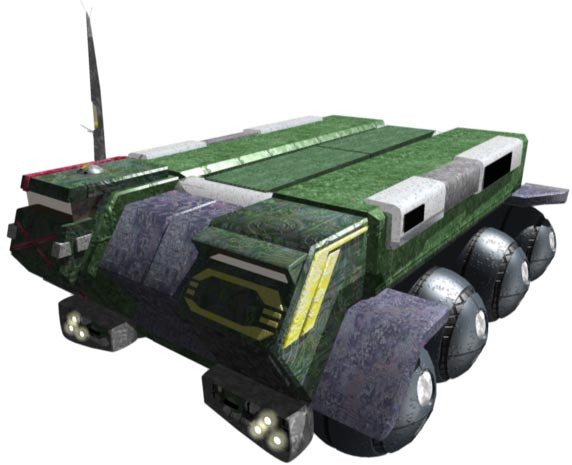
Before the departure of the REF, the SOC series were conceived as mobile orbital defense headquarters. Although the headquarters were intended to make use of remote missile launchers and ASAT-equipped aerospace fighters, the hull was given a large number of heavy anti-ship missiles as well, to form a reserve supply and to be used in massive saturation attacks.
The SOC came equipped with a comprehensive package of orbital sensors, both located on the vehicle as well as in dispersed pods that could be up to a thousand kilometers distant. Secure communications with the off-board sensors, diverse ASAT missile launchers, and with other major REF assets (such as headquarters and ships) were also provided for. The resulting system could coordinate the orbital defense, for an area of the size of the continent of Europe.
Originally, a number of Quell Quallie Zentraedi auxiliaries were to have been converted for this task, but it was decided instead to use a new design, as the Quell Quallie proved to be difficult to maintain by the RDF forces, and larger than required as well.
The SOC was designed to undock from its transport vessel, then slowly approach the planet it was to protect. Naturally, this could only been done when at the very least aerospace superiority had been achieved, and preferably after aerospace supremacy was won. While this may sound to be at odds with the SOC's designed function, it must be remembered that the SOC was not designed to achieve superiority, but to maintain it until permanent defense centers could be constructed, typically deep under mountain ranges, such as the Khazadum complex in the Rocky Mountains. As the SOC approached its destination, the sensor drop-pods were released in a pattern that would offer maximum sensor coverage over the continent. Typically, the pods were landed high in mountain ranges several hundreds to thousands of kilometers from the SOC landing point. The drop-pods housing these unique relays and orbital sensors were built on the standard REF pod specifications, and as a consequence any REF drop-pod could be mounted. However, historically, the SOC always deployed its own sensor pods exclusively.
Due to its lack of aerodynamics, the SOC was to use its gravity system to reduce its relative speed to the planet to minimal values, then slowly descend into the atmosphere, thus avoiding the fiery re-entry of high-speed craft. When in the atmosphere, the SOC would use its thrusters and anti-gravity system to move in the operations area, never deploying without a security force or near enemy positions. The net result was a mobile air defense center that was both smaller and easier to maintain than the proposed Zentraedi Quell Quallie refits.
Initially, the Titan was deployed to Tirol, and formed the air defense headquarters for the invading REF army. As such, it performed as designed, coordinating the destruction of several Invid ships that tried to run the REF blockade and made it to Tirol's atmosphere. However, also during the Tirol campaign, the REF encountered the Invid force fields for the first time, and found themselves without a weapon capable of breaking these protections down without levelling the surrounding area. Therefore, a new crash program was initiated. Eventually, this program would produce the Little Monster destroid series and the Syncro cannon designs.In the meantime though a stopgap solution had to be found.
This solution was to convert the SOC craft to GMU siege engines. The entire superstructure aft of the cockpit and mecha bay was torn down,and replaced with a large particle cannon, two rotating side bodies, and two erectable flare shields. The GMU could descend to a planet in the same manner as the SOC, touch down near an Invid Hive (assuming all external defensive forces had already been destroyed) and then let loose at the force field until it shorted out and troops could enter the hive.
This naturally left the REF without a major part of its orbital defense systems, and as a stopgap replacement, some salvaged Roil Tiluvo corvettes were fitted with the required command, control and communications equipment. To compensate for the lower number of missile launchers, a larger number of Vulture fighters was assigned to the REF Air Force for service as ASAT launchers.
The GMU's served with the REF and the Sentinels for four years, until the Little Monsters replaced them in the front lines. The four GMU's were returned to Tirol, where they were re-converted into an improved SOC configuration. They served in the Opteran campaign, but thereafter were restricted to Tirol when the Invid war devolved into a large number of smaller actions. It was not until 2044 that the three of the SOC's were shipped to the front lines again, for the liberation of Earth. However, the Titan was destroyed with the UES Saratoga and the Leviathan with the UES Hood which transported them, before they could reach the planet. The Colossus survived the assault in reserve with the rest of the ground forces on the moon, and was placed there in mothballs two years after the war, and sold to the Terran War Museum a few years after that. The Goliath became a part of the Tirolian Army after the war, although was placed in reserve even before her sister.
Return to REF Vehicles Index
Go to Robotech Reference Guide Home Page.
Robotech (R) is the property of Harmony Gold. This document is in no way intended to infringe upon their rights.
Design by Pieter Thomassen